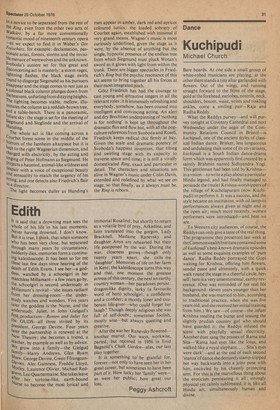Dance
Kuchipudi
Michael Church
Bare boards. At one side a small group of white-robed musicians are playing, at the other there stands a tiny altar garlanded with flowers. Out of the wings, and running straight forward to the front of the stage, gold at the forehead, earlobes, nostrils, neck, shoulders, bosom, waist, wrists and tinkling ankles, come a smiling pair—Raja and Radha Reddy.
What the Reddys purvey—and will purvey tonight at Coventry Cathedral and next Wednesday under the aegis of the Community Relations Council in Bristol—is kuchipudi, one of the ancient styles of classical Indian dance. Brisker, less languorous and undulating than some of its co-variants, kuchipudi is a South Indian dance-drama form which was apparently first created by a saintly Brahmin named Sidhyendra Yogi. This gentleman had been told by Krishna— in a vision—to write a play about a particular Hindu legend, and had finally managed to persuade the (male) Krishna-worshippers of the village of Kuchelapuram (now Kuchipudi) to perform it. It was a success, and the style became an institution, with oil lamp-lit performances always given at night and in the open air; much more recently, women performers were introduced—and here we are.
To Western city audiences, of course, the Reddys can only give a taste of the real thing. The programme they presented last week at theCommonwealth Institutecontained some of kuchipudi's best-known dramatic episodes as well as some exquisite examples of 'pure dance'. Radha Reddy portrayed the Gopi waiting for Krishna, offering him flowers, sandal paste and ultimately, with a quick walk round the stage in a cheerful circle, herself; hers is a very unsentimental, earthy reverence. (One was reminded of her real life background: eleven years younger than her husband, she was married to him, according to traditional practice, when she was five years old, and she received her initial training from him.) We saw—of course—the infant Krishna stealing the butter and teasing the slightly prudish country girl who should have guarded it : the Reddys infused the scene with playfully sexual electricity. Another duet sang the praises of Rama and Sita—'Rama had eyes like the lotus, and walked like a royal elephant. . . . Sita's eyes were dark'—and at the end of each second `stanza'of dance she demurely stamp-tripped her way backwards into a joint pose with him, encircled by his chastely protecting arm. For this is the marvellous thing about the eroticism permeating it all : strongly physical yet calmly sublimated, it is, like all Hindu art, simultaneously human and divine.










































 Previous page
Previous page